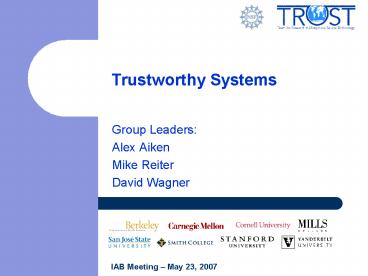Trustworthy Systems - PowerPoint PPT Presentation
1 / 19
Title:
Trustworthy Systems
Description:
Kernel may corrupt memory by inadvertent dereference of malicious user-created pointer ... Convince a remote party that security-sensitive code was protected ... – PowerPoint PPT presentation
Number of Views:28
Avg rating:3.0/5.0
Title: Trustworthy Systems
1
Trustworthy Systems
- Group Leaders
- Alex Aiken
- Mike Reiter
- David Wagner
2
Scope
- Includes at least
- Trustworthiness via software analysis
- Trustworthiness via hardware assist
- Trustworthiness by distribution
- The primary home for secure systems and
software research in TRUST
3
Trustworthiness via Software Analysis
- Spotlights
- Joe-E A language for security
- David Wagner
- Static analysis for security
- Alex Aiken and David Wagner
4
Joe-EA Language for Security
- Problem Current systems fail to follow the
principle of least privilege - This contributes to the virus and worm problem
- Joe-E a new programming language designed to
support least privilege and privilege separation - Designed as a subset of Java, to ease adoption
- Tech transfer Joe-E is being used by HP Labs to
build Waterken, an extensible web server
5
Joe-E The approach
All variables haveglobal scope
Global variablesconsidered harmful
Languages withlexical scoping
(poor practice)
(better practice)
(language support)
All privilegesglobally accessible
Privilege separationprivs are module-local
Joe-E global scopeprovides no privilege
6
Security via Static Analysis Goals
- Research direction Reason about software
security properties, using program analysis
type inference - Goal Reduce occurrence, impact of security bugs
manual audits,grep
Best-effort bugfinding
Soundness
Verify absence of classes of bugs
???
full program verification
7
Security via Static AnalysisExample
User/Kernel Bugs
- OS kernel and user share the same address space
- Kernel must take care with user-created pointers
- Kernel may corrupt memory by inadvertent
dereference of malicious user-created pointer
8
Security via Static Analysis A User/Kernel
Security Hole
Kernel code
int x void sys_setint(int p) memcpy(x, p,
sizeof(x)) void sys_getint(int p) memcpy(p,
x, sizeof(x))
- Attack what if p points into kernel memory?
- Attacker can read secrets from kernel buffers
- Attacker can gain root privileges e.g., by
overwriting his own euid with all zeros
9
Security via Static AnalysisResearch Issues
- Operating Systems are hard to analyze
- Big Linux has 6MLOC
- Complex High density of tricky code
- Path-sensitive approach
- For each program point
- For each pointer p
- Compute a boolean condition under which p is a
checked/unchecked user pointer - Use SAT to test satisfiability of conditions
- An extreme in path sensitive analysis
10
Security via Static AnalysisCurrent Results
- Analyze all of Linux
- Currently gives 450 warnings on all of Linux
- Most of these could be eliminated with more work
- Less than 1 warning/10,000 LOC
- Analysis derives sound aliasing information
- But assumes memory safety
- E.g., no buffer overflows
- A separate problem to check . . .
11
Trustworthiness via Hardware Assist
- Spotlight
- Minimal TCB code execution
- Adrian Perrig and Mike Reiter
12
Minimal TCB Code ExecutionTrusted Computing
Base (TCB)
App
App 1
App
App 1
S
S
OS
OS
Shim
DMA Devices
DMA Devices
CPU, RAM TPM, Chipset
CPU, RAM TPM, Chipset
(Network, Disk, USB, etc.)
(Network, Disk, USB, etc.)
13
Minimal TCB Code ExecutionContributions
- Isolate security-sensitive code execution from
all other code and devices - Convince a remote party that security-sensitive
code was protected - Attest to security-sensitive code and its
arguments and nothing else - Add lt 250 LoC to the software TCB
S
Software TCB
lt 250 LoC
Shim
14
Minimal TCB Code Execution Architecture Overview
- Exploit capabilities of new commodity CPUs (SVM
for AMD, TXT for Intel) - Core technique
- Pause current execution environment
- Execute security-sensitive code with
hardware-enforced isolation - Resume previous execution
- Extensions
- Preserve state securely across invocations
- Attest to code execution and protection (and
nothing else) - Establish secure communication with remote parties
15
Trustworthiness by Distribution
- Spotlight
- Nightwatch An auditing framework for large scale
distributed systems - Robbert van Renesse
16
NightwatchMotivation
- Distributed systems are complex
- Unexpected failures may occur
- Software bugs
- Network failures
- Unpredicted load
- Improper tuning
- Rational or malicious behavior
17
NightwatchHybrid auditing model
- Hybrid global local auditors scheme
- Probabilistic querying
- Internal fault tolerance
- Adaptivity to current conditions
18
NightwatchProbabilistic Auditing
- We target systems that do not require immediate
detection - Local auditors randomly look for unsatisfied
invariants between fixed intervals of time - This approach is attractive for large-scale
systems that cannot rely on a vast amount of
resources
19
NightwatchCase Study Multimedia Dissemination
- We use auditing to avoid nodes without enough
upload capacity from affecting the quality of
streaming - We use multiple layers with different download
rates based on the upload rates of its members.
Higher layers provide higher quality data.































